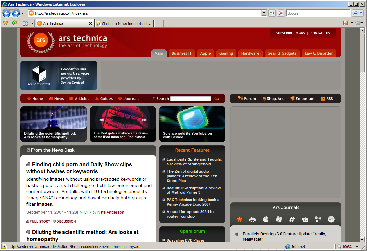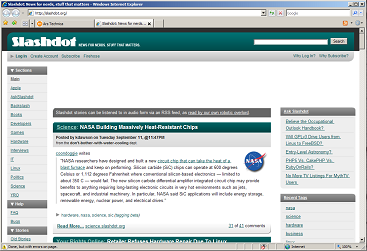In my Intro to Algorithms course in college the Fibonacci sequence was used as the example algorithm to which various types of algorithm creation methods were applied. As the course went on we made
better and better performing algorithms to find the nth Fibonacci number. In another course we were told about a matrix that when multiplied successively produced Fibonacci numbers. In my linear
algebra courses I realized I could diagonalize the matrix to find a non-recursive Fibonacci function. To my surprise this worked and I
found a function.

Looking online I found that of course this same function was already well known. Mostly I was irritated that after all the
algorithms we created for faster and faster Fibonacci functions we were never told about a constant time function like this.
I recently found my paper depicting this and thought it would be a good thing to use to try out MathML, a markup language for displaying math. I went to the MathML implementations page and installed a plugin for IE to display MathML and then began writing up my paper in MathML. I wrote the MathML by hand and must say that's not how its intended to be created. The language is very verbose and it took me a long time to get the page of equations transcribed.
MathML has presentation elements and content elements that can be used separately or together. I stuck to content elements and while it looked great in IE with my extension when I tried it in FireFox which has builtin MathML support it didn't render. As it turns out FireFox doesn't support MathML content elements. I had already finished creating this page by hand and wasn't about to switch to content elements. Also, in order to get IE to render a MathML document, the document needs directives at the top for specific IE extensions which is a pain. Thankfully, the W3C has a MathML cross platform stylesheet. You just include this XSL at the top of your XHTML page and it turns content elements into appropriate presentation elements, and inserts all the known IE extension goo required for you. So now my page can look lovely and all the ickiness to get it to render is contained in the W3C's XSL.
 I recently finished Braid, the Xbox Live game, and a comparison with Portal is helpful. From a screen shot Braid
looks like a normal 2D platformer, but that's like looking at a screen shot of Portal and saying its a first person shooter. While the scaffolding of the game-play may sort of fall into that
category, the games are actually about exploring the character's ability and solving puzzles. In Portal the ability is bending space and in Braid its bending time. However, whereas in Portal there
is one space bending mechanism, the portal gun, Braid's protagonist explores several different time bending techniques including, most prominently, reversing time, but also time dilation, multiple
time-lines, and other odd things.
I recently finished Braid, the Xbox Live game, and a comparison with Portal is helpful. From a screen shot Braid
looks like a normal 2D platformer, but that's like looking at a screen shot of Portal and saying its a first person shooter. While the scaffolding of the game-play may sort of fall into that
category, the games are actually about exploring the character's ability and solving puzzles. In Portal the ability is bending space and in Braid its bending time. However, whereas in Portal there
is one space bending mechanism, the portal gun, Braid's protagonist explores several different time bending techniques including, most prominently, reversing time, but also time dilation, multiple
time-lines, and other odd things.
Similar to the difference in game-play, while Portal has a strict simplicity to its visual style, Braid is much more ornate, like you're playing in an oil painting. Without seeing video of the game, or playing the demo (which is available for free on Xbox Live) its difficult to convey, but it is quite lovely and the animation adds quite a bit. Both games too are rather short leaving you just a bit hungry for more and have an interesting plot and an ending that I'd hate to spoil although Braid replaces Portal's humor with melancholy. If you enjoyed Portal and Twelve Monkeys then I'd recommend Braid.
![['Neverending story' by Alexandre Duret-Lutz. A framed photo of books with the droste effect applied. Licensed under creative commons.]](http://farm1.static.flickr.com/90/252757784_3de44cbeb4_m_d.jpg) Information about URI Fragments, the portion of URIs
that follow the '#' at the end and that are used to navigate within a document, is scattered throughout various documents which I usually have to hunt down. Instead I'll link to them all here.
Information about URI Fragments, the portion of URIs
that follow the '#' at the end and that are used to navigate within a document, is scattered throughout various documents which I usually have to hunt down. Instead I'll link to them all here.
Definitions. Fragments are defined in the URI RFC which states that they're used to identify a secondary resource that is related to the primary resource identified by the URI as a subset of the primary, a view of the primary, or some other resource described by the primary. The interpretation of a fragment is based on the mime type of the primary resource. Tim Berners-Lee notes that determining fragment meaning from mime type is a problem because a single URI may contain a single fragment, however over HTTP a single URI can result in the same logical resource represented in different mime types. So there's one fragment but multiple mime types and so multiple interpretations of the one fragment. The URI RFC says that if an author has a single resource available in multiple mime types then the author must ensure that the various representations of a single resource must all resolve fragments to the same logical secondary resource. Depending on which mime types you're dealing with this is either not easy or not possible.
HTTP. In HTTP when URIs are used, the fragment is not included. The General Syntax section of the HTTP standard says it uses the definitions of 'URI-reference' (which includes the fragment), 'absoluteURI', and 'relativeURI' (which don't include the fragment) from the URI RFC. However, the 'URI-reference' term doesn't actually appear in the BNF for the protocol. Accordingly the headers like 'Request-URI', 'Content-Location', 'Location', and 'Referer' which include URIs are defined with 'absoluteURI' or 'relativeURI' and don't include the fragment. This is in keeping with the original fragment definition which says that the fragment is used as a view of the original resource and consequently only needed for resolution on the client. Additionally, the URI RFC explicitly notes that not including the fragment is a privacy feature such that page authors won't be able to stop clients from viewing whatever fragments the client chooses. This seems like an odd claim given that if the author wanted to selectively restrict access to portions of documents there are other options for them like breaking out the parts of a single resource to which the author wishes to restrict access into separate resources.
HTML. In HTML, the HTML mime type RFC defines HTML's fragment use which consists of fragments referring to elements with a corresponding 'id' attribute or one of a particular set of elements with a corresponding 'name' attribute. The HTML spec discusses fragment use additionally noting that the names and ids must be unique in the document and that they must consist of only US-ASCII characters. The ID and NAME attributes are further restricted in section 6 to only consist of alphanumerics, the hyphen, period, colon, and underscore. This is a subset of the characters allowed in the URI fragment so no encoding is discussed since technically its not needed. However, practically speaking, browsers like FireFox and Internet Explorer allow for names and ids containing characters outside of the defined set including characters that must be percent-encoded to appear in a URI fragment. The interpretation of percent-encoded characters in fragments for HTML documents is not consistent across browsers (or in some cases within the same browser) especially for the percent-encoded percent.
Text. Text/plain recently got a fragment definition that allows fragments to refer to particular lines or characters within a text document. The scheme no longer includes regular expressions, which disappointed me at first, but in retrospect is probably good idea for increasing the adoption of this fragment scheme and for avoiding the potential for ubiquitous DoS via regex. One of the authors also notes this on his blog. I look forward to the day when this scheme is widely implemented.
XML. XML has the XPointer framework to define its fragment structure as noted by the XML mime type definition. XPointer consists of a general scheme that contains subschemes that identify a subset of an XML document. Its too bad such a thing wasn't adopted for URI fragments in general to solve the problem of a single resource with multiple mime type representations. I wrote more about XPointer when I worked on hacking XPointer into IE.
SVG and MPEG. Through the Media Fragments Working Group I found a couple more fragment scheme definitions. SVG's fragment scheme is defined in the SVG documentation and looks similar to XML's. MPEG has one defined but I could only find it as an ISO document "Text of ISO/IEC FCD 21000-17 MPEG-12 FID" and not as an RFC which is a little disturbing.
AJAX. AJAX websites have used fragments as an escape hatch for two issues that I've seen. The first is getting a unique URL for versions of a page that are produced on the client by script. The fragment may be changed by script without forcing the page to reload. This goes outside the rules of the standards by using HTML fragments in a fashion not called out by the HTML spec. but it does seem to be inline with the spirit of the fragment in that it is a subview of the original resource and interpretted client side. The other hack-ier use of the fragment in AJAX is for cross domain communication. The basic idea is that different frames or windows may not communicate in normal fashions if they have different domains but they can view each other's URLs and accordingly can change their own fragments in order to send a message out to those who know where to look. IMO this is not inline with the spirit of the fragment but is rather a cool hack.
![[Many books in large bookcase. Photo creator http://flickr.com/people/babblingdweeb/]](http://farm1.static.flickr.com/18/23816128_d4acb70b2d_m_d.jpg) I use my recently added
books feed from LibraryThing, a site I've mentioned before where you track, review, recommend, and share your books, and I put the recently added
books on my page. I thought it might be nice to include the book covers so I suggested adding book covers to RSS feeds in
LibraryThings 'Recommend Site Improvements' group. The next day I had a response from the founder and lead developer Tim Spalding who
had started implementing the feature. I noticed a few bugs, reported them on the same thread, and he fixed them soon after. Fantastic! It makes me want to upgrade to a paying account.
I use my recently added
books feed from LibraryThing, a site I've mentioned before where you track, review, recommend, and share your books, and I put the recently added
books on my page. I thought it might be nice to include the book covers so I suggested adding book covers to RSS feeds in
LibraryThings 'Recommend Site Improvements' group. The next day I had a response from the founder and lead developer Tim Spalding who
had started implementing the feature. I noticed a few bugs, reported them on the same thread, and he fixed them soon after. Fantastic! It makes me want to upgrade to a paying account.
Incidentally, if you notice the Ghost in the Shell book appear multiple times in my RSS feed its due to the previously mentioned iterative bug fixes. The same item appeared multiple times slightly differently with each bug fix and your RSS aggregator may have picked them up as distinct items.
 I wanted to give a brief update on what's been going on for me this weekend and the previous two.
I wanted to give a brief update on what's been going on for me this weekend and the previous two.
